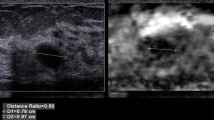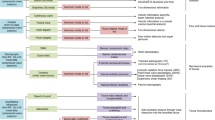Abstract
Minimal invasive device insertion into the soft tissue is a very important medical approach that is helpful for local drug delivery, biopsy, regional anesthesia, blood sampling, and radiofrequency ablation. These methods need to introduce the MID inside the body for exploring the tissue texture pattern. We propose a novel approach by acquiring acoustic emission data from the proximal end of the MID for the tissue using phase angle, power spectral to identify the texture. By performing these signal processing approach to the soft tissue, the pattern of the tissue can be understood. The result shows a new study to obtain soft tissue texture information.
Access provided by Autonomous University of Puebla. Download conference paper PDF
Similar content being viewed by others
Keywords
1 Introduction
Nowadays, physicians are facing the problem to determine the abnormal tissue such as ovarian cyst or tumor in the body, which is very challenging. Numerous recent clinical practices are involved in soft tissue treatment and some local therapies. Advanced technologies are used in the laparoscopic surgery that allows finding the accurate information of the soft tissue characteristics [1].
There are many devices available in the market such as biopsy needle, catheter and guidewire for regional anesthesia, and brachytherapy which considered as a medical interventional device (MID). These applications, needle and catheters have to penetrate into the soft tissue to find the texture information of the soft tissue. The effectiveness of the diagnosis is depended on the accuracy of the penetration of the device into the soft tissue. Medical studies have revealed that misplacement of the needle insertion into the soft tissue will be a problematic [2, 3]. Nowadays, through the MID insertion procedure has become a very significant way to evaluate the texture of the tissue because a variety of pathological conditions in humans directly or indirectly involve remodeling or regenerating the collagenous framework in tissue. Accurate placement of MID is very important because biopsy of an unintended tissue region can effect in misdiagnosis.
Many studies suggest that the inappropriate MID insertion can be caused by many factors like tissue in homogeneity, tissue anisotropy, anatomical obstructions. A MID has assumed as the rigid rod and the soft tissue has elasticity property to deform under the external forces and to release stored energy to drive the function of other tissues. MID penetration method is divided into pre-puncture, puncture and post-puncture phases. Soft tissue deformation happens at the pre-puncture and post puncture phases [4,5,6]. There are numerous irregular gaps inside the tissue and the tissue is simply compressible under the external loads. When MID goes into the soft tissue leads to the volume change with its deformation. This volume change of the tissue can be used to measure the deformation. Tissue deformation includes three cases which are the displacement of the tissue, comparative sliding of multilayer soft tissue and motions of the organs. usually, soft tissue contains three layers which are skin, muscle, and fat. The inhomogeneous characteristic sallow the adjective layers to slide with each other under the asymmetrical forces [7]. The connection between needle deflection and needle geometry are discussed [8]. In general, when a tensile event happens, the sides of the deformation move away from each other, and consequently, a few energy transmits in the waveforms which means acoustic emission waveform emitted by a tensile event.
However, it is very hard to calculate the changed volume of soft tissue but we are trying to get some information about the tissue texture. The impact of the research presented in this paper lies in its contribution to extract the texture comparison information of the soft tissue using the audio signal.
2 Method
In this research, we setup the experiment for MID which was an 18G 200 mm length biopsy needle with the needle core (ITP, Germany), placed inside a flushed 1.9 F micro catheter of 1.5 m length were implemented. A gelatin phantom was filled with different fruits such as grape, persimmon, breast and, liver of chicken to perform the analysis (Fig. 1). We attached a microphone to the proximal end of the needle to the soft tissue (Gelatine phantom filled with fruits) using testing machine (Zwicki, Zwick GmbH & Co. KG, Ulm).
Penetration velocity rate of the needle was 3 mm/s, recorded 80 audio signals in WAV format with a sampling frequency of 44672 Hz because it is very common sampling frequency in the digital audio system. Insertion of the needle timing and exit timing were observed. We performed the filtration process to obtain the filtered audio signal from the raw audio signal (Fig. 2). In this study, we focused on the signal processing to find the texture of the tissue using the audio signal. We used the biopsy needle to get the match in the different structures of tissue. The experimental tissues were persimmon, grape, breast and liver of chicken with different texture of the tissue. Since It is very important to implement a signal processing approach to get more hidden information which is not possible by naked eyes.
The Matlab R2015b is used to perform signal processing for the audio signal analysis. The algorithm used on filtered audio signal for the digital analysis of amplitude, frequency, phase angle pattern detection among the tissue successfully [9,10,11]. Finally, we performed cross-correlation to determine inter-observer and intra-observer variability. The objective of this research is to evaluate tissue texture when the needle passes into dissimilar tissue structures.
3 Results
In this section, we observed more friction dynamics in the breast and liver of chicken at the time of needle penetration rather than fruits, obtained different elasticities of tissue structures which is different patterns of the soft tissue. We particular made the block on the graph where is the more different peaks variation clearly differentiate from other tissue (Fig. 3). Numerous research suggests the muscle tissue is composed out of different fibre strands and fruit tissue have different. These kind of alignment will lead to a directed light distribution with the fibre direction in the piece of tissue. After performing the power spectral, phase angle among the tissues. Power spectral graph represents the difference among the tissue which is shown in the graph (Fig. 3). Though, frequency distribution is important for human perception. These kinds of information may be acquired by computation power spectrum.
Phase angel graph is also representing the difference among the tissues, we have shown in the graph (Fig. 4). In the graph, we have made the block where is the dense area which is fibre that also differentiate the tissue pattern to each other. The phase angle (p(α, \( \varphi^{\prime } \), \( \theta^{\prime } \))) of the soft tissues have strong deviations at the incident of penetration and scattering angles (\( \varphi^{\prime } \), \( \theta^{\prime } \)). MID insertion is directed into fibre direction that can propagate to get the inside organization of the tissue. We compared all results of the soft tissue texture pattern. Our comparison reveals differences among the soft tissues that can be seen pattern consistency of the data.
Finally, we performed the cross-correlation to get the pattern among the tissue which is shown in the graph as well (Fig. 5). Here, we have shown the graph only a few signal patterns for the representation purpose. Upper and lower part of the graph peaks are different that shows the variability of the signal at different points (Fig. 5). We obtained the angle variation that strongly dependent on the incident direction.
This study shows an interesting approach to get fruitful information between the MID and tissue. This experiment was performed in a laboratory controlled physiological environment. We strongly believe that this research would play a very significant role in medical science.
4 Conclusions
This research suggests that it is a novel method to extract the helpful information of the Medical interventional device. We used advanced signal processing algorithms to get the in-homogeneities and elasticity properties of that tissues and obtained the texture difference in between. As we know, In the clinical world where digital pathology is becoming more popular, automatic classification could be a very helpful tool for the pathologist. and it could provide a new direction to the medical science.
References
Horgan, S., Vanuno, D.: Robots in laparoscopic surgery. J. Laparoendosc. Adv. Surg. Tech. 11(6), 415–419 (2001)
Abolhassani, N., Patel, R.: Deflection of a flexible needle during insertion into soft tissue. In: Engineering in Medicine and Biology Society, 2006. EMBS 2006. 28th Annual International Conference of the IEEE, pp. 3858–3861. IEEE (2006)
Illanes, A., Boese, A., Maldonado, I., Pashazadeh, A., Schaufler, A., Navab, N., Friebe, M.: Novel clinical device tracking and tissue event characterization using proximally placed audio signal acquisition and processing. Sci. Rep. 8(1), 12070 (2018)
van Gerwen, D.J., Dankelman, J., van den Dobbelsteen, J.J.: Needle–tissue interaction forces–A survey of experimental data. Med. Eng. Phys. 34(6), 665–680 (2012)
Dedong, G.A.O., Yong, L.E.I., Bin, Y.A.O.: Analysis of Dynamic Tissue Deformation during Needle Insertion into Soft Tissue. IFAC Proc. Volumes 46(5), 684–691 (2013)
Mostaço-Guidolin, L.B., Ko, A.C.T., Wang, F., Xiang, B., Hewko, M., Tian, G., Sowa, M.G.: Collagen morphology and texture analysis: from statistics to classification. Sci. Rep. 3, 2190 (2013)
Lee, H.K., Chung, J., Chang, S.I., Yoon, E.: Real-time measurement of the three-axis contact force distribution using a flexible capacitive polymer tactile sensor. J. Micromech. Microeng. 21(3), 035010 (2011)
Okamura, A.M., Simone, C., O’leary, M.D.: Force modeling for needle insertion into soft tissue. IEEE Trans. Biomed. Eng. 51(10), 1707–1716 (2004)
Boedeker, K.L., McNitt-Gray, M.F.: Application of the noise power spectrum in modern diagnostic MDCT: part II. noise power spectra and signal to noise. Phys. Med. Biol. 52(14), 4047 (2007)
Kienle, A., Forster, F.K., Hibst, R.: Influence of the phase function on determination of the optical properties of biological tissue by spatially resolved reflectance. Opt. Lett. 26(20), 1571–1573 (2001)
Cheong, W.F., Prahl, S.A., Welch, A.J.: A review of the optical properties of biological tissues. IEEE J. Quantum Electron. 26(12), 2166–2185 (1990)
Acknowledgment
This work was supported by Deutscher Akademischer Austauschdienst (DAAD), Germany. We thank to INKA research (OVGU, Magdeburg, Germany) Group for the cooperation.
Author information
Authors and Affiliations
Corresponding author
Editor information
Editors and Affiliations
Ethics declarations
We have no conflicts of interest relationship with any companies or commercial organizations.
Rights and permissions
Copyright information
© 2020 Springer Nature Switzerland AG
About this paper
Cite this paper
Singh, Y., Hu, WC., Illanes, A., Friebe, M. (2020). Exploring the Possibilities to Characterize the Soft Tissue Using Acoustic Emission Waveforms. In: Lin, KP., Magjarevic, R., de Carvalho, P. (eds) Future Trends in Biomedical and Health Informatics and Cybersecurity in Medical Devices. ICBHI 2019. IFMBE Proceedings, vol 74. Springer, Cham. https://doi.org/10.1007/978-3-030-30636-6_2
Download citation
DOI: https://doi.org/10.1007/978-3-030-30636-6_2
Published:
Publisher Name: Springer, Cham
Print ISBN: 978-3-030-30635-9
Online ISBN: 978-3-030-30636-6
eBook Packages: EngineeringEngineering (R0)









